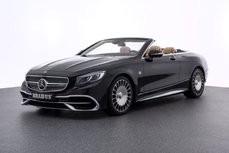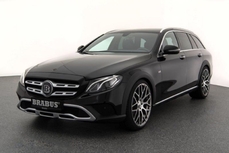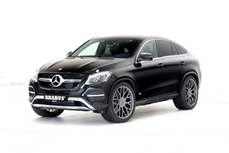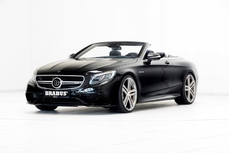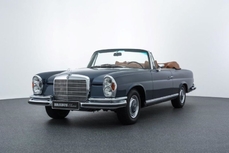Mercedes-Benz BRABUS D4 auf Basis GLC 250 d Coupé
General description :
BRABUS D4
auf Basis GLC 250 d
Ehemaliger Listenneupreis inkl. 19% MwSt.: 78.773,24 €
Sonderausstattung ab Werk:
040 Schwarz
114 Ledernachbildung ARTICO espressobraun / schwarz
218 Rückfahrkamera
234 Totwinkel-Assistent
235 Aktiver Park-Assistent inkl. PARKTRONIC
249 Innen- und Außenspiegel automatisch abblendbar
280 Multifunktionslenkrad in Leder
293 Sidebags im Fond
309 Doppelcupholder
345 Scheibenwischer mit Regensensor
355 Vorrüstung Garmin® MAP PILOT
357 Garmin® MAP PILOT
379 Auto-Telefonie
414 Schiebedach
421 Getriebe Automatik 9-Gang, 9G-TRONIC
440 Tempomat mit var. Geschwindigkeitsbegrenzung Limiter
448 Touchpad
474 Dieselpartikelfilter
486 Sportfahrwerk
500 Außenspiegel links und rechts elektrisch heranklappbar
518 Media Interface Kabel Kit
51U Innenhimmel in schwarz
522 Radio Audio 20 CD
543 Sonnenblenden mit beleuchtetem Spiegel
551 Einbruch- und Diebstahl-Warnanlage (EDW)
581 Klimatisierungsautomatik THERMOTRONIC
608 Adaptiver Fernlicht-Assistent
632 LED High Performance-Scheinwerfer
723 EASY-PACK-Laderaumabdeckung
724 Vorrüstung für Dachträgersysteme
840 Wärmedämmendes dunkel getöntes Glas rundum ab B-Säule
873 Sitzheizung vorne
875 Scheibenwaschanlage beheizt
876 Innenraumlichtpaket
882 Innenraumabsicherung
890 EASY-PACK-Heckklappe
893 KEYLESS-GO Start-Funktion
8U8 i-Size-Kinder-Rückhaltesystem
900 Chrom-Paket
916 Kraftstofftank 66l
B03 ECO-Start-Stopp-Funktion
B51 TIREFITB59DYNAMIC SELECT
H07 Zierelemente Holz Linde linestructure braun glänzend
K11 Adaptives Bremslicht blinkend
P22 EXCLUSIVE Interieur
P49 Spiegel-Paket
P54 Diebstahlschutz-Paket
P55 Night-Paket
P65 Sitzkomfort-Paket
P76 Serienausstattung Exterieur
R39 LM-Räder (4fach) im 5-Speichen-Design, 19" schwarz
U09 Instrumententafel und Bordkanten der Türen in ARTICO
U10 Automatische Beifahrerairbag-Abschaltung
U60 Aktive Motorhaube
U85 AdBlue® Behälter mit größerem VolumenBRABUS Sonderausstattung ab Werk:
BRABUS ECO PowerXtra Kit D4+ 23 kW / 31 PS, + 50 Nm auf 173 kW / 235 PS, 550 Nm
BRABUS SoundXtraActive Sound System
BRABUS Start-Stop MemoryZusatzsteuergerät zum Speichern der Start-Stop Einstellung
BRABUS Heckspoiler
BRABUS Heckscheibenaufsatz
BRABUS Monoblock T Leichtmetallräder 20-Zoll - "Sterlingsilber" mit Carbon-Intarsien
BRABUS Bodenschoner Velours schwarz, mit Nubuk-KanteHinweis:
Aktueller KM-Stand: 963 KM - Keine Erstzulassung!!
Leasing und Finanzierung möglich
Besichtigung vor Ort möglich!
Änderungen, Irrtümer und Zwischenverkauf vorbehalten!
http://home.mobile.de/BRABUS#des_237931793
Mercedes-Benz BRABUS D4 auf Basis GLC 250 d Coupé is listed sold on ClassicDigest in Brabus-Allee 1DE-46240 Bottrop by Auto Dealer for Not priced.
Car Facts
Car type : Car Make : Mercedes-Benz Model : BRABUS Model Version : D4 auf Basis GLC 250 d Coupé Engine size : 2.1 Sub type : Pick up Location : Brabus-Allee 1DE-46240 Bottrop
Sold
Seller Information
Sold
People who viewed this Mercedes-Benz BRABUS also viewed similar Mercedes-Benz listed at ClassicDigest
Other cars listed for sale by this dealer
About Mercedes-Benz
In the annals of automotive history, the journey of Mercedes-Benz is a tale that unfolds with the ingenuity of its founding pioneers. In the year 1886, Karl Benz crafted the Benz Patent Motorwagen, a creation that would go down in history as the world's inaugural automobile. Unbeknownst to him, this moment marked the genesis of what would evolve into the most illustrious premium car manufacturer globally. The financial underpinning of this pioneering venture, interestingly, was provided by Karl Benz's wife, Bertha Benz, demonstrating a remarkable partnership that would set the tone for Mercedes-Benz's legacy.A parallel narrative emerged not far away, as Daimler-Motoren-Gesellschaft, founded by Gottlieb Daimler and Wilhelm Maybach, entered the scene. In 1901, they unveiled their automobile under the now-famous moniker "Mercedes," meaning "godsend" in Spanish. This name was bestowed upon the car at the behest of Emil Jellinek's daughter, the distributor for Daimler-Motoren-Gesellschaft. The wheels of innovation were set in motion.
Fast forward to 1926, a pivotal year that witnessed the merger of Daimler with Benz & Cie., culminating in the birth of Daimler-Benz. The amalgamation saw the adoption of "Mercedes-Benz" as the distinguished trademark for their automobiles, fusing the legacies of two visionary entities into one.
Contrary to perceptions of conservatism, the trajectory of Daimler-Benz unfolds as a chronicle of industry firsts. From the introduction of the honeycomb radiator to the float carburetor, and the pioneering implementation of four-wheel brakes in 1924, Daimler-Benz consistently pushed the boundaries of automotive innovation. The diesel-powered Mercedes-Benz 260 D in 1936 marked the inception of diesel engines in passenger cars. The iconic Mercedes-Benz 300SL Gullwing made history as the first car with direct fuel injection, albeit the Gutbrod's tiny 2-stroke engine can claim precedence.
Safety innovations became a hallmark, with Béla Barényi's patented safety cell design in the "Ponton"-models in 1951, featuring front and rear crumple zones. The W116 450SEL 6.9 saw the introduction of the Anti-Lock Brake system (ABS), another pioneering safety feature. From the first production airbags and beyond, the legacy of "firsts" continued to be etched into the fabric of Daimler-Benz.
Over its centennial journey, Mercedes-Benz has not merely produced cars but has sculpted automotive icons. The SSKL, 710 SSK Trossi Roadster, 770K Grosser, 540K Spezial Roadster, 300SL Gullwing, w100 600 Pullman, w111 280SE 3.5 Flachkühler, w113 230SL Pagoda, w109 300 SEL 6.3, and w201 2.3-16 Cosworth stand testament to the brand's commitment to engineering excellence.
The roaring Silver Arrows, or "Silberpfeile," including the W 25, W 125, W154, W165, and W196, created a legacy of dominance on the racetrack. These machines were not merely cars; they were expressions of precision, speed, and an indomitable spirit that left their competitors in the dust.
As Mercedes-Benz marches into the future, it does so not just as an automaker but as a custodian of a legacy, a torchbearer of innovation, and a beacon of automotive excellence. The road ahead is sure to witness the continued fusion of cutting-edge technology, timeless design, and an unwavering commitment to setting new standards in the world of automobiles.
One luminary figure who left an indelible mark was Béla Barényi, often heralded as the "father of passive safety" for his pioneering work in safety engineering. His patented safety cell design, featuring front and rear crumple zones, became a hallmark of Mercedes-Benz's commitment to occupant safety, setting new standards that reverberated throughout the automotive world.
Moving through the chronicles, the collaborative genius of Wilhelm Maybach, alongside Gottlieb Daimler, laid the foundation for Daimler-Motoren-Gesellschaft. Their innovations not only birthed the first Mercedes but established a culture of relentless pursuit of technological excellence that remains integral to Mercedes-Benz's DNA.
In the post-merger era of 1926, Ferdinand Porsche emerged as a prominent figure within Mercedes-Benz. His work on the Mercedes-Benz S-Type, a supercharged race car, garnered acclaim and set the stage for a legacy that extended far beyond the marque. Porsche's impact would later extend to his eponymous company, but his influence at Mercedes-Benz during those formative years was pivotal.
As the 20th century progressed, the legendary Rudolf Uhlenhaut emerged as a key figure. Uhlenhaut, an accomplished engineer and the driving force behind the iconic Silver Arrows, played a crucial role in Mercedes-Benz's dominance in motorsports. His engineering prowess and attention to detail were instrumental in creating some of the most formidable racing cars of the era.
In the latter half of the century, figures like Bruno Sacco, the head of design at Mercedes-Benz from 1975 to 1999, left an indelible imprint on the brand's aesthetic identity. Sacco's design philosophy, characterized by clean lines and timeless elegance, shaped iconic models like the W126 S-Class and the W201 190E, solidifying Mercedes-Benz's reputation for luxury and sophistication.
The narrative would be incomplete without acknowledging the contributions of engineers like Hans Scherenberg, whose leadership in the 1970s ushered in a new era of technological innovation at Mercedes-Benz. Scherenberg's tenure saw the development of groundbreaking technologies, including the Anti-Lock Brake system (ABS) and the introduction of airbags in production cars.


